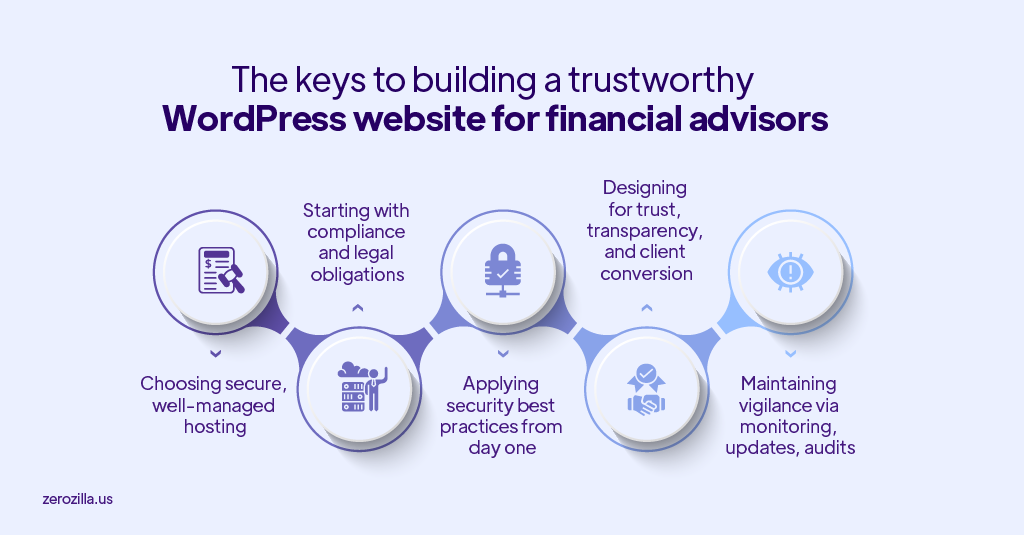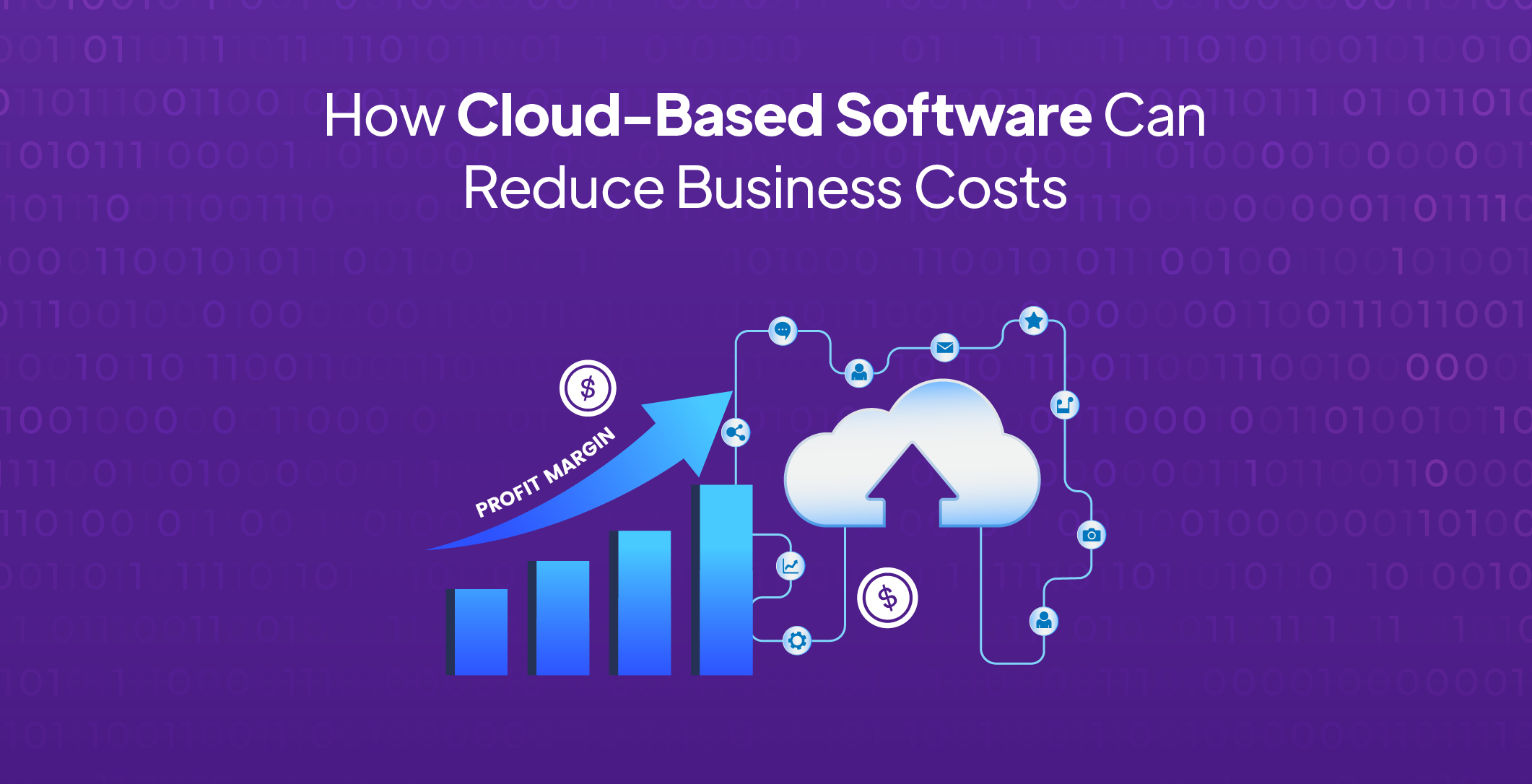In a world where clients expect instant access, impeccable credibility, and strict privacy, having a strong online presence is essential for financial advisory firms. A well‑built website not only showcases your services but also demonstrates that you are trustworthy, compliant, and capable of protecting sensitive client data.
Using WordPress gives you the tools and flexibility you need; but only when you set it up correctly. In this guide you will learn how to create a financial advisor website using WordPress that is secure, compliant, and inspires confidence.
Why WordPress Is a Strong Choice for Financial Advisors
WordPress has become one of the most popular platforms for websites of all kinds and for good reason. For financial advisors, in particular, it offers distinct advantages, while also posing certain risks. Understanding both sides helps you make decisions early in your website planning process.
Flexibility & Customization
With WordPress, you have almost unlimited flexibility in how your site looks and works. You can choose a theme (free or premium), use page builders (Elementor, Beaver Builder, Divi, etc.), or even build custom themes or child themes. For financial advisors, this means you can design a website that reflects your brand- colors, fonts, images, layout- while also integrating tools like calculators, client portals, forms, or booking systems. The ability to customize means you can tailor your site to your specific niche (retirement planning, wealth management, taxation, etc.).
Plugin Ecosystem and Contributions
Because WordPress is widely used, many developers build plugins that add functionality: secure forms, backups, analytics, SEO, performance optimization, security firewalls, etc. For advisors, this means you can pick and choose tools to add exactly what you need (for instance, a GDPR‑compliant cookie consent plugin, secure client login, or even document upload features). But you must be selective: poorly coded, abandoned, or outdated plugins can become security holes.
User-Friendly Content Management
WordPress makes ongoing content creation (blog posts, educational articles, resources) quite accessible. For financial advisors, this is essential: regularly publishing content establishes expertise, helps with SEO, builds trust, and answers prospective clients’ questions. Being able to update content without needing deep technical skills is a big plus.
Cost‑Effectiveness
Comparatively, a WordPress‑based site is often cheaper to build, host, and maintain than a fully custom-built application. You can start modestly, basic hosting, theme, essential plugins and expand as your practice grows. That said, cost savings disappear if you ignore security, hire low‑quality contractors, or neglect maintenance.
Risks and Considerations
The flip side: WordPress’s enormous popularity makes it a frequent target for hackers. Themes or plugins with security flaws, outdated core code, weak hosting, or unpatched environments can make your site vulnerable. If your website handles or stores sensitive client information (financial data, personally identifiable information), any breach could have serious legal, reputational, and financial consequences. So your use of WordPress must be paired with disciplined planning, security, and compliance.
Key Legal & Compliance Requirements in the U.S.
| Regulation / Entity | What Applies to Your Website | Key Requirements |
| SEC (for Registered Investment Advisors, RIAs) | All RIAs must follow rules around marketing, disclosure, record‑keeping. | Disclosures: Form ADV, conflict of interest, advisory status; preserving advertising materials; disclaimers that content is educational; record retention (often ≥ 5 years). |
| FINRA (for broker‑dealers) | If you or your firm is under FINRA oversight, your website is considered a communication with the public. | Promotions must be fair, balanced, not misleading; disclosures; policies for testimonials and endorsements. |
| Privacy Laws (e.g., Gramm‑Leach‑Bliley Act, FTC rules, CCPA if dealing with Californians) | Any collection, storage, or processing of personal identifying or financial information must comply. | Must have explicit Privacy Policy; clear statements about information collected, who sees it, how protected; cookie policy / opt‑outs; secure transmission. |
| Cybersecurity / Data Security Expectations | Even if not spelled out in law, both SEC rules and best practices demand reasonable cybersecurity. | Use HTTPS, encryption in transit and at rest (as appropriate), access controls, incident response plan; likely audit logs. |
| Accessibility (ADA / WCAG) | U.S. websites, especially those public‑facing, may face legal risk if not accessible to people with disabilities. | Aim for WCAG AA compliance; alt‑text for images; keyboard navigability; ARIA attributes; readable structure. |
Choosing the Right Hosting + WordPress Setup
Your WordPress site’s security, speed, and reliability start with the foundation. Here’s what to look for:
Hosting
- Managed WordPress Hosting: Providers include WP Engine, Kinsta, Flywheel, SiteGround, etc. They often provide automatic core updates, daily backups, staging environments, built‑in caching and security tools.
- Server Security: Choose providers that offer isolation between accounts, secure physical datacenters, regular patching of OS / PHP / MySQL.
- SSL / HTTPS: SSL certificates are essential (Let’s Encrypt or paid); they enable HTTPS, which secures data in transit.
WordPress Configuration
- Use the latest stable WordPress core version.
- Use well‑coded, regularly updated themes & plugins. Avoid ones from unknown sources.
- Keep PHP, MySQL / MariaDB versions up to date (supported by host).
- Use child themes if modifying theme files.
Environment & Tools
- Set up staging or development environment for testing changes before pushing live.
- Version control (e.g., Git) for theme or custom plugin code if you have custom development.
- Use secure credentials: unique database name, strong passwords.
Planning the Structure and Content of Your Financial Advisor Website WordPress
While technical security is critical, trust comes from what visitors see: clarity, transparency, usability, relevant content, and good design. Planning structure and content beforehand will save redesign and compliance headaches.
What Pages & Content Should Be Included
Start with foundational pages. These are not optional; clients and regulators expect them.
- Home Page: This is where first impressions are made. You want a clean, professional design; a strong value proposition that tells visitors who you are, what type of clients you serve, what makes your advisory distinct. Include trust signals up front: licenses, affiliations, years in business, perhaps a few short quotes or logos. Make navigation obvious, load speed fast.
- About / Team Page: People trust people. Show your credentials (licenses, certifications like CFP, CFA, etc.), education, backgrounds, possibly a photo or video. Explain your Philosophy: how you approach financial planning, investments, risk, etc. If you work with a team, present them too with transparency.
- Services: Clearly describe what you offer. If you do retirement planning, investment management, tax planning, estate planning, etc., each should have its own content explaining what that service includes, what clients can expect, pricing structure if appropriate (or at least fee models), what deliverables.
- Resources / Blog / Insights: This helps with both SEO and trust. Write content that addresses common client questions (e.g. “How much should I save for retirement?”, “What’s the difference between fiduciary and suitability standard?”, “How do market downturns affect long‑term plan?”, etc.). Use this section to demonstrate expertise, keep visitors engaged, and indirectly site security (fresh content, updates) because stale sites may look neglected.
- Privacy Policy, Disclosures, Terms of Use: These are legal must‑haves. Do not hide them; put links in the footer, ensure they are easy to read. For example, privacy policy should say what data is collected, how used, how stored, any third party services, cookies, etc. Disclosures should make clear what regulatory bodies you are registered with, what fees you charge, caution that past performance is no guarantee, etc.
- Contact Page: Multiple ways to contact you (phone, email, address, contact form). If you have a physical office, listing address adds trust. For the contact form, ensure security measures: CAPTCHA, validation, HTTPS submission. If possible, have a calendar‐booking tool to allow prospective clients to schedule consults, which reduces friction.
- Client Portal / Secure File Exchange (if you offer): If clients need to share sensitive documents (tax returns, financial statements, etc.), a secure portal is very helpful. But it adds security demands: encryption, strong access controls, audit trails. Make sure you choose plugins/tools that are well designed for that.
- FAQ Section: Anticipate questions around your process, fees, security of their data, your credentials, how you protect information. This both builds trust and reduces repetitive queries.
Designing for Trust & Usability
The way your site looks and behaves contributes greatly to trustworthiness,even if you cannot see it, users feel it.
- Design Should Be Clean, Professional, and Consistent: Use high‑quality images (real photos of team, office if possible), avoid cliché stock photos, maintain consistent branding (colors, fonts). The tone should reflect professionalism. Avoid clutter.
- Load Speed & Mobile Responsiveness: Many users will access on mobile. A site that loads slowly or looks broken on phones harms trust. Use good hosting, caching, image optimization, minimal heavy scripts.
- Navigation & Simplicity: Visitors should find what they need without digging. Keep the menu simple, group pages logically. For example, put “Services” as a top menu, “Resources” or “Blog” another. Use breadcrumbs if helpful.
- Visible Trust Cues: SSL padlock, “https://” in URL, badges/certifications displayed, if you’re registered with FINRA, SEC, or state board, show that. If you carry insurance (E&O), consider displaying that. Use client testimonials (if compliant) with names, credentials, ideally video or photo. Show that you follow best practices.
- Secure Forms & Data Collection: Contact forms, newsletter signups, calculator inputs. They must be secure (SSL), minimized (only ask for what you need), sanitization of inputs, and using CAPTCHA or anti‑spam measures. Be very careful if you allow file uploads (limit file types, size, use virus scanning, store them securely).
Security Best Practices: Hardening & Maintenance
Now to the practical steps to build a secure WordPress website for finance.
| Practice | What It Does | How To Implement |
| SSL / HTTPS | Secures data in transit (login, form submissions). | Get SSL certificate; force site traffic via HTTPS; update internal links. |
| Strong passwords & user roles | Prevent brute force / unauthorized access. | Use password managers; limit login attempts; assign least privilege. |
| Two‑Factor Authentication (2FA) | Adds second layer on login. | Use plugins like Google Authenticator, Authy, or built‑in solutions from host/security plugin. |
| Limit login attempts & use renaming / lockdown of wp‑admin | Reduces brute force attack exposure. | Plugins or host tools; change default admin username; restrict access by IP for admin area. |
| Disable file editing inside WordPress | Prevents modifications via admin if someone gains access. | In wp‑config.php set define(‘DISALLOW_FILE_EDIT’, true);. |
| Proper file permissions | Ensures server files cannot be modified by unauthorized code/users. | Use permissions like 644 for files, 755 for folders; follow host recommendations. |
Plugins and services that help with security
- Security audit / scanner plugins (e.g. Sucuri, Wordfence).
- Firewall (web application firewall – WAF).
- Malware detection / scanning.
- Backup tools that store off‑site (cloud).
- SSL certificate / auto‑renew management.
Regular maintenance & updates
- Update WordPress core, theme, plugins as soon as updates are available, after testing in staging.
- Remove unused plugins/themes.
- Monitor logs: failed login attempts, suspicious traffic.
- Routine backups; periodically test restore.
Advanced protection (if needed)
- Harden database: custom table prefix, restrict access.
- Use intrusion detection / prevention systems.
- Implement Content Security Policy (CSP), HTTP security headers (X‑Frame‑Options, X‑Content‑Type‑Options, etc.).
- Use secure hosting with malware scanning, proactive monitoring.
Trust Signals, UX & Design Features
Making your website look secure and establishing trust is as important as actual security measures: people must feel safe to share info or contact you.
- Display security badges, trust seals, SSL padlock icon.
- Show certifications/licenses (CFP®, CFA®, state registrations).
- Testimonials (if compliant): gather real reviews; ensure they are up‑to‑date and with necessary disclosures.
- Privacy Policy & Terms of Use clearly linked in footer.
- Transparent pricing or fee structure if possible.
- Team bios with credentials.
- Visible contact info; possibly an office address if applicable.
- Use secure forms (e.g. forms that submit via HTTPS, CAPTCHA, validation).
Plugins & Tools to Aid Security, Compliance, and Trust
Here are specific plugin/tool recommendations and what to look for in a financial planning website builder context.
| Function | Recommended Plugins / Tools | What to Check For |
| Security scan & firewall | Wordfence, Sucuri Security, iThemes Security | Frequency of scans, real‑time protection, firewall rules, reputation. |
| Backup & restore | UpdraftPlus, BackWPup, BlogVault | Automated schedule, off‑site storage (e.g. AWS, Dropbox), test restoration. |
| 2FA & login security | Two‑Factor plugins, Google Authenticator, WP 2FA | Easy setup, support for multiple users, backup codes. |
| Malware / vulnerability monitoring | Sucuri, MalCare, Jetpack Security | Trail logs; alerts; remediation support. |
| Compliance tools | Plugins for cookies / consent (e.g. CookieYes, Complianz), privacy policy generators, GDPR/CCPA tools | Ability to customize disclosures; logging; being able to opt‑out. |
| Accessibility tools | WP Accessibility plugin, tools to check WCAG compliance | Keyboard navigation; alt tags; color contrast; ARIA. |
| Analytics & performance | Google Analytics (with Privacy compliance), caching (WP Rocket etc.), CDN (Cloudflare) | Page speed; visitor trust via fast site; avoid “laggy” UX. |
Ensure any plugin used is regularly updated, well supported, and has good reviews. Unvetted or abandonware plugins are common attack vectors.
Checklist Before Launch
Before you make your website public or update an existing one, you should walk through a full checklist in practice to make sure nothing is overlooked. This helps ensure your financial advisor website WordPress is secure, compliant, and will give visitors trust.
Here are key items (explained so you know why each matters):
- Hosting, SSL, and server environment ready: Without SSL (HTTPS) visitors will get warnings; data in transit may be intercepted. Make sure host is secure and supports features like latest PHP, TLS, etc.
- WordPress core, theme, plugins up to date and tested: If you launch with outdated components, you may be vulnerable from day one. Testing in staging helps ensure updates do not break site features.
- All required legal content is in place: Privacy Policy, Disclosures (Form ADV etc.), Terms of Use. These protect you legally and build transparency.
- Forms are secure, minimal, validated: Contact / lead capture forms must not collect unnecessary personal data; must be protected from spam and abuse; must transmit securely; make sure uploads are safe.
- Accessibility tested: Ensure site works on mobile, supports keyboard navigation, images have alt text, color contrasts are sufficient. Testing with real users and tools.
- Speed & performance optimized: Slow sites frustrate visitors and look unprofessional. Ensure images compressed, scripts minimized, caching enabled, possibly use CDN.
- Trust signals visible: Credentials/licensures, regulatory registrations, client contact info, location/address if applicable, security or SSL badges. These reassure visitors.
- Backup & restore plan in place: You need to know that if something goes wrong, malware, hack, bad update, you can roll back quickly with minimal downtime or data loss.
- Security hardening done: Admin area locked down; file permissions correct; disabling file editing; login protections; 2FA; failure login monitoring; firewall in place.
- Analytics & monitoring set up: Track site traffic; monitor downtime; set up alerts for suspicious activity; error logs; possibly periodic security audit.
Ongoing Monitoring, Updates, and Audit
Launching the site marks only the beginning; your security and trustworthiness are only as good as your ongoing maintenance, responsiveness to changes, and capacity to adapt to new threats and regulation.
Keeping Up with Updates
WordPress core, theme, and plugin developers frequently release updates, often to patch security vulnerabilities. Even minor version updates can fix serious flaws. When possible, use a staging or test site to apply updates first; verify functionality; then deploy to production. Also subscribe to update notifications for critical components so you’re alerted immediately.
Security Audits & Penetration Testing
Every so often (e.g. annually, or after substantial changes), conduct a security audit: use automated vulnerability scanners, check configuration, test for common vulnerabilities (XSS, SQL injection, insecure file upload). If budget allows, hire a professional penetration tester to simulate attacks. Also monitor logs; look at failed login, unexpected file changes, unusual traffic spikes.
Compliance Reviews & Legal Check‑Ins
Laws, regulations, and industry standards evolve. For example, privacy laws change at state level; SEC/FINRA rules get updated; internet‑based advisor registration rules may shift. Periodically review your disclosures, privacy policy, testimonials procedures to ensure everything is still compliant. It helps to have a compliance consultant or attorney review your website content and processes every 1–2 years.
Monitoring Trust, UX, and Feedback
Track visitor behavior: which pages have high bounce rates? Are people leaving from contact pages? Do forms convert? Solicit feedback from clients: do they feel the site is professional? Is information easy to find? You may need to adjust design, menu structure, or content based on real‑user behavior.
Incident Preparedness
Even with all precautions, breaches or server failures can happen. Have an incident response plan: know who will be responsible; how you’ll communicate with clients; how you’ll restore from backups; what regulatory obligations (notifications etc.) you have. Document this plan, assign roles, test it occasionally.
Conclusion
Building a secure website on WordPress for financial advisors is absolutely feasible. In fact, when done correctly, WordPress can be your financial planning website builder of choice for flexibility, content control, and credibility.

If you follow the practices above, your WordPress financial advisor website will not only protect sensitive data, but also become a center of trust for prospects, signals of professionalism, and a growth tool for your business
Looking for expert help in building a compliant, high-performing, and secure WordPress website for your financial advisory business? Zerozilla specializes in WordPress development tailored for finance professionals, ensuring trust, security, and conversion-driven design from day one.
Let Zerozilla handle the complexity, so you can focus on delivering exceptional financial guidance



